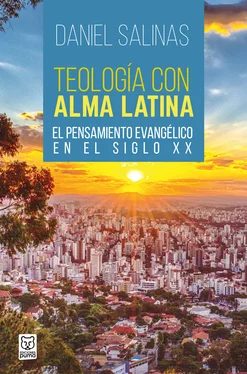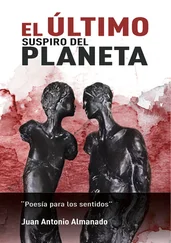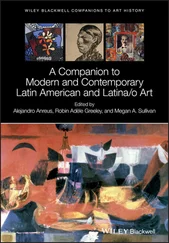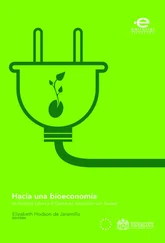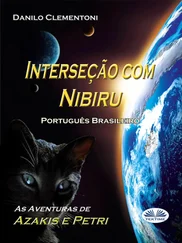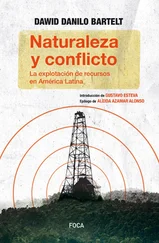7Christian Lalive D’Épinay, Les protestantismes latino-américains: Un modèle typologique, Arch. Sociol. Des Rel., 30, 1970, pp. 33–57.
8Carlos Mondragón demuestra la presencia endógena de la disensión religiosa temprana como elemento de contacto para los misioneros extranjeros. Ibíd., 13. En contraste, Lalive D’Épinay argumenta que la presencia protestante en América Latina fue “labor exclusiva de extranjeros apoyados por organizaciones extranjeras”. “Toward a typology of Latin American Protestantism”, The Review of Religious Research, 10, 1, 1968, p. 7.
9Samuel Escobar, “¿Somos fundamentalistas?” Pensamiento Cristiano 13, 1966, pp. 88–96. Samuel Escobar, “¿Qué significa ser evangélico hoy?” Revista Misión 1, 1982: 14–18, pp. 35–39.
10Oscar A. Campos R., “La misión de la iglesia y el reino de Dios en el evangelicalismo tradicional”, Kairós 21, 1997, p. 53.
11Juan Sepúlveda ubica en 1902 el comienzo del movimiento pentecostal en Chile. Religious practices and developments: The case of chilean pentecostalism.
12CCLA, Committee of Cooperation in Latin America, Christian Work in Latin America: Survey and occupation, message and method, Education, vols. 1, 3, New York: The Missionary Education Movement of the United States and Canada, 1917; CCLA, Committee of Cooperation in Latin America, Christian Work in Latin America: Literature, Women’s Work, the Church in the Field, the Home Base, vol. 2, New York City: The Missionary Education Movement of the United States and Canada, 1917; CCLA, Committee of Cooperation in Latin America, Christian Work in Latin America: Cooperation and the Promotion of Unity, the Training and Efficiency of Missionaries, the Devotional Addresses, the Popular Addresses, vol. 3, New York City: Missionary Education Movement of the United States and Canada, 1917.
13No pretendo negar que hubo también razones ideológicas, aunque vale la pena reconocer que los actores principales en Panamá no estaban conscientes de ellas. El análisis de las ideologías detrás del congreso es más bien reciente. Para esto, ver el trabajo de Arturo Piedra, Evangelización protestante en América Latina. Análisis de las razones que justificaron y promovieron la expansión protestante 1830–1960, vol. 1, San José: Universidad Bíblica Latinoamericana, 2005; Arturo Piedra, Evangelización protestante en América Latina. Análisis de las razones que justificaron y promovieron la expansión protestante, vol. 2, Quito: CLAI, 2005.
14Committee of Cooperation in Latin America, Christian Work in Latin America: Survey and Occupation, Message and Method, Education, vol. 1, p.136.
15Ibíd., pp. 79 ss., 192.
16Ibíd., p. 245.
17Ibíd., p. 130.
18Ibíd., p. 140.
19Ibíd., p. 144.
20Ibíd., p. 16.
21Robert E. Speer, Missions in South America, New York: The Board of Foreign Missions of the Presbyterian Church in the USA, 1909; Robert E. Speer, South American Problems, New York: Student Volunteer Movement for Foreign Missions, 1912.
22Speer, Missions in South America, p. 151.
23Ibíd., p. 152.
24Ibíd., p. 153.
25Ibíd., p. 154.
26Ibíd.
27Ibíd., p. 159.
28American Track Society, Ecumenical Missionary Conference New York, 1900: Report of the Ecumenical Conference on Foreign Missions, Held in Carnigie Hall and Neighboring Churches, April 21 to May 1, vol. 1, New York: American Track Society, 1900, p. 476.
29Speer, Missions in South America, p. 161.
30Ibíd.
31Ibíd., p. 162.
32Ibíd., p. 163.
33Ibíd., p. 168.
34Ibíd., p. 169.
35Committee of Cooperation in Latin America, Christian Work in Latin America: Cooperation and the Promotion of Unity, The Training and Efficiency of Missionaries, the Devotional Addresses, the Popular Addresses, p. 54.
36Ibíd.
37James C. Dekker, “North American Protestant Theology: Impact on Central America”, Evangelical Review of Theology 9, n.° 3, julio, 1985, p. 386.
38Committee of Cooperation in Latin America, Christian Work in Latin America: Survey and Occupation, Message and Method, Education, vol. 1, pp. 274–82.
39Ibíd., p. 281.
40Ibíd., p. 312.
41Ibíd., p. 313.
42Ibíd., pp. 283–300.
43Ibíd., p. 292.
44Ibíd., p. 294.
45Ibíd., p. 297.
46CCLA Committee of Cooperation in Latin America, Regional Conferences in Latin America, New York City: The Missionary Education Movement, 1917, p. 426.
47Ibíd., p. 101.
48Robert E. Speer, Samuel G. Inman y Frank K. Sanders, eds., Christian Work in South America: Official Report of the Congress on Christian Work in South America, at Montevideo, Uruguay, Abril, 1925, vol. 1, ed. CCLA, 2 vols., vol. 1: Unoccupied Fields, Indians, Education, Evangelism, Social Movements, Health Industry, New York and Chicago: Fleming H. Revell Company, 1925, p. 350–62.
49Ibíd., p. 351.
50Robert E. Speer, Samuel G. Inman y Frank K. Sanders, eds., Christian Work in South America: Official Report of the Congress on Christian Work in South America, at Montevideo, Uruguay, April, 1925. vol. 2, ed. CCLA, 2 vols., vol. 2: Church and the Community, Religious Education, Literature, Relations Between Foreign and National Workers, Special Religous Problems, Cooperation and Unity, New York y Chicago: Fleming H. Revell Company, 1925, p. 366.
51Speer, Inman y Sanders, Christian Work in South America: Official Report of the Congress on Christian Work in South America, at Montevideo, Uruguay, Abril, 1925. vol. 1, p. 353.
52Speer, Inman y Sanders, Christian Work in South America: Official Report of the Congress on Christian Work in South America, at Montevideo, Uruguay, Abril, 1925. vol. 2, p. 366.
53Speer, Inman y Sanders, Christian Work in South America: Official Report of the Congress on Christian Work in South America, at Montevideo, Uruguay, Abril, 1925. vol. 1, p. 353.
54Ibíd., p. 355.
55Ibíd., p. 356.
56Ver el informe de la Comisión V. sobre los movimientos sociales, ibíd., pp. 389–494.
57Ibíd., p. 363.
58Ibíd., p. 364.
59Gonzalo Báez-Camargo, Hacia la renovación religiosa en Hispano-América: Resumen e interpretación del Congreso Evangélico Hispano-Americano de La Habana, México: Casa Unida de Publicaciones, 1930, p. 24.
60Samuel G. Inman, Ventures in Inter-American Friendship, New York: Missionary Movement of the United States and Canada, 1925, p. 6.
61Speer, Inman, and Sanders, Christian Work in South America: Official Report of the Congress on Christian Work in South America, at Montevideo, Uruguay, Abril, 1925. vol. 2, p. 360.
62Samuel G. Inman, New Churches in old lands: Thoughts Concerning the Evangelical Movement in Hispanic America, Especially in View of Discussions Related to the Havana Congress, 1929, p. 1.
63Julio Navarro Monzó, The Religious Problem in Latin American Culture, Montevideo: Young Men’s Christian Association, 1925, p. 56.
64Ibíd., p. 58.
65Báez-Camargo, p. 25.
66Ibíd., p. 27.
67Ibíd., p. 138.
68Ibíd., pp. 157–58. Para un análisis de la declaración de Jerusalén y algunos de los problemas relacionados ver James L. Cox, “Jerusalem 1928: Its Message for Today”. Missiology: an International Review 9, n.° 2, abril, 1981, pp. 139–53.
69CAM, The Central American Bulletin 22, n.° 1, 1916, p. 4.
70La Biblia anotada por Scofield se considera “la distribuidora más influyente del dispensacionalismo en (Norte) América”. Ernest R. Sandeen, “Toward a Historical Interpretation of the Origins of Fundamentalism”. Church History 36, n.° 1, 1967, p. 68.
71CAM, “Origen and Purpose of the Mission,” The Central American Bulletin 3, n.° 2, 1897, p. 2.
72Ver, por ejemplo, Alan Thomas Terlep, “Inventing the Rapture: The Formation of American Dispensationalism, 1850–1875” (disertación doctoral), University of Chicago, 2010.
Читать дальше
